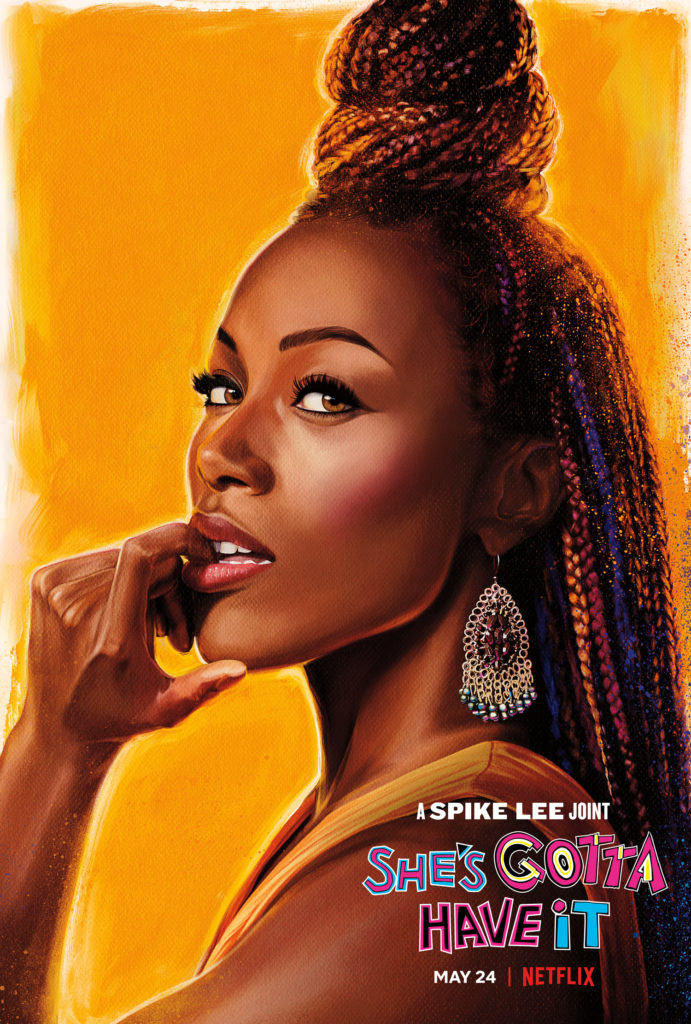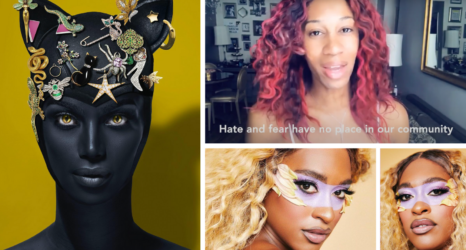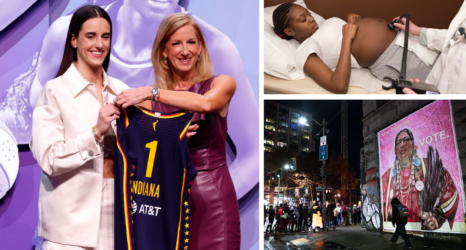The Netflix series “She’s Gotta Have It”—created by Academy Award-winning filmmaker Spike Lee, with encouragement from wife and executive producer, Tonya Lewis Lee—broadens the narrative of the original debut by Lee of the same name.
The provocative indie film from 1986, filmed in black and white, focused primarily on the main character’s erotic appetite, and her clear-cut attitude about sex in the opening scene—the original Nola Darling, played by Tracy Camilla Johns, was introduced in bed, where she defended her polyamorous lifestyle without remorse. When the new Netflix protagonist, DeWanda Wise, established her own sexual manifesto as Nola Darling in Season 1, she expanded the story’s scope to include issues of body esteem, misogyny, PTSD and even gentrification.
Radha Blank, one of the show’s writers and producers—whose writing credits include “The Get Down” (Netflix), “Empire” (Fox), “Monster” (Tonik Productions) and her forthcoming feature film, The 40-Year-Old Version, along with various plays—helped steer that expansion. The Sundance Fellow and multi-award winning playwright opened up to Ms. about her journey to the SGHI writers’ room, the liberation of writing a character who’s at peace with her body and what the writers became obsessed with during Season 2—premiering May 24 on Netflix.
Let’s start with your backstory and career,and how you became a writer and produce for the series.
I was raised in Williamsburg Brooklyn in the late seventies by a painter and a jazz musician who encouraged me to perform and tell story. My neighborhood included Black artists, Puerto Rican biker gangs and Hasids—so my work as a playwright of twenty-plus years has often centered on questions of what makes a community as well as the outsider/insider relationship, especially when the outsider looks like the members of a certain community but comes from a different belief system. How does looking like someone inform your obligation to them if it does at all?
Spike was looking to populate his room with playwrights, folks obsessed with character, folks invested in earning character’s leaps and landings. But he was also looking for that New Yawk voice. That’s me, all day, e’rrday. At any moment when pitching, I’ll break into a different accent. I can’t help it. You know they say the New York accent will be obsolete in 20 years? Suuuucks.
Anyway, I had a boricua accent up until middle school. Then I went to Philippa Schuyler in Bushwick with more “Brooklyn Browns” like our very own Shemekka in the series.
I got that New York sauce, nahmean?
The social narratives of She’s Gotta Have It are far more provocative than the sexual content. In the first season, you covered the dangerous extremes some women undergo to alter their bodies, and how such insecurities can play on the psyche of their daughters or young girls in general.
I am a Black woman who was once a Black girl who—like many girls coming up in the city—covered up in winter coats to avoid the leering of people, mostly older men, at my young developing Black body. Even other girls would look, scrutinize or admire your young Black body, because we’ve all been conditioned to do so. Sarah Baartman, anyone?
Every day in a Black body can evoke a number of responses—fear, envy, desire, fascination, attack or disdain. This is often before the person in the Black body gets a chance to engage it, or find safety, self-love, understanding or an appreciation for it. especially if the body’s been attacked or exploited. As a teaching artist for many years in and around New York, I’d often hear my young black girl students speaking my past insecurities about my body right back to me, so this is ongoing.
With Nola, a young Black woman at the center of the show, we get to see someone who’s found peace in her body. A woman who doesn’t apologize for what she does and doesn’t do with her body. It was liberating for me to write a character like this.
In this day and age, this kind of Black woman character may not feel as much of a revolution or revelation as it was with the original Nola in Spike’s 1986 film. But for the series, as Nola navigates her relationships and friendships, she almost becomes a satellite—collecting data on how the women around her, and her distinct lovers, respond to her body as well as their own. The show gives us an opportunity to continue the conversation about the Black Body, especially in the episode where Nola is arrested and put in central booking. The conversation sparked questions around safety and authority and how this impacts the Black Body.

In that gentrification episode, you also addressed multiple topics—from cultural biases and loyal friends to the self-actualization of Nola’s character.
Many of us in the writing room were either born-and-raised or lived in New York neighborhoods that became extensions of our families and identity. We’ve had to contend with the city’s culture changing right before our eyes. My parents were gentrifiers in their own way—entering a new community, looking to settle there—but it was how they entered, with their hands open to those who came before them. They engaged residents and offered up art or drumming classes— maybe as a way to disarm, but also to say “hi, I want in, what can I do?”
Gentrification in New York rarely looks like this anymore, and often leaves the prior “settlers” diminished, ignored and disregarded. Everybody wants that cheap Harlem apartment! Hey, we’re glad we got some fresh produce and soy milk options at the corner bodega, but don’t turn your nose up at us. We give the city the flavor you clamor here for. New York culture does not exist without the loud folks from immigrant or Black or Latinx communities, queer folk or poor artists. If our drumming circle is too loud for you, go someplace quiet—but don’t call the cops to erase what disturbs you. You just got here!
This is some gentrifiers’ answer to everything: calling the cops. It’s like the last weapon in a game of Mortal Combat. “Oh yeah well I’ll call the cops!” aka “finish him!” They know when the cops show up, and it’s your word against mine, if the cop is not a friend to the neighborhood, the way it used to be, he’s taking your side. That is wielded over us often.
I think Nola had a revelation in that gentrification episode. She had just come to a place of power in her relationships, further ownership of her sexuality and her dreams, her voice, her choice—and yet in one moment, it could have been diminished by an arrest, one due to a gentrifier being “disturbed” by Papo, a fixture in the neighborhood.
The self-actualization of Nola’s character—where Nola realizes she can take care of herself without relying on a man—gives an empowering message that women [can] support themselves by tapping into their God-given abilities. Was this scripted with a feminist voice? Is it your intent to employ feminist content into your work?
I don’t know how we couldn’t employ a feminist voice in the series. Spike ain’t no dummy! He knew to hire whip-smart-opinionated-ass-women for his room and in his cast—women who will challenge perceptions around how we are seen, who we are and can be. We would get into it—deeply passionate debates around sexuality, relationships, dreams and politics—and because the women writers are a force in the room, we were heard.
The thing about playwrights as TV writers: you get a chance to develop clarity around one’s voice before joining a writing room, so when you finally do, you know what’s important to you. And while we are all different kinds of Black women, we are Black women—mirroring and echoing some of the same concerns around identity and the issues pertaining to a woman like Nola.
For my own work, I don’t employ much of anything that isn’t my truth. I have to be myself. That includes my race and gender, but it includes so much more. I think Nola, at her heart, is a woman artist fighting to find her voice for herself and in her work. In a world that often diminishes women around their gender, Nola’s POV and journey is inherently feminist—without us needing to state, imply or force that.
How will you use Nola’s role as an artist in the second season to curate other messages or point of views that are important toyou?
This season Nola will dive deeper into the rivers of love, relationships and sex positivity. But we also see Nola exploring the lives of other Black artists in an effort to understand how one can thrive, not just survive, as an artist, while trying to create a legacy.
One of our obsessions in the room this season was the life, career and legacy of Zora Neale Hurston. How did this woman—who gave us some of the richest writing of our time, gave us one of the most important archives on Black life—towards the end of her life, work as a domestic to support herself, only to be buried in an unmarked grave? Zora died in damn-near obscurity until Alice Walker unearthed her works in the seventies.
How does that happen? Was it simply the isms of the time? Did we fail her? Conversely, how does a writer like the incomparable Toni Morrison, or a gifted young painter like Amy Sherald, find their voices and their success in this century?
In a country that often ignores and undervalues the voice of Black women, it becomes a chance to shine a light on the struggle of the artist—something each of us in the room has had to contend with. This season Nola really examines the ideas of success, as well as the impact one’s art can have, while contemplating the difference between identifying one’s self as an artist or as a Black Artist.
Oh—and, of course, there’s gonna be some juicy relationshit madness too.

She’s Gotta Have [It] can mean many things aside from sexual conquests, and offers room to expand the story lines. What specific “itism” would you like to see pursued, and what important journeys would you like the characters to undergo in the future?
The “it” in She’s Gotta Have It has expanded since Spike shot the original film. For the Nola of that classic work, “it” represented her need for sexual freedom and freedom from the confines of traditional gender roles and relationships. The “it” in the series seems to reflect a woman with an insatiable appetite for her truth.
“It” is whatever Nola wants and needs in a given moment. The “it” becomes an answer to a question around who she is and what she values. Sometimes for Nola, the search for “it” leads to clarity. Sometimes it leads to a stumble and fall. But we watch Nola get up time and time again because of her insatiable need for the truth, no matter the costs.
My hope for the character is that she keeps evolving. If the series follows Nola into her thirties and beyond, it would be nice to see her still learning about who she is. This amplifies women as ever evolving, learning new things about ourselves at any age. To learn what is possible, and to still have dreams as we mature.
Right now, visual artist Simone Leigh’s piece “Brick House”—a colossal, mega ton, steel Black woman bust with cornrows, thank you!—is being installed by cranes to New York’s High Line. It will be a permanent fixture at the outdoor park, hovering over the city. Maybe we get to see Nola have that kind of “it,” that kind of fortune and accomplishment, as a grown-ass Black Woman Artist.
Can you tell us how aspiring screenwriters can break into the industry?
There is no easy answer to this. Whether you’re coming from an academic program or not, I think a new writer should take the time to discover what their voice, or voices, are—outside of academia.
Travel. Get into debates. Live abroad. Break up to make up to break up. Have life experiences that will help shape your point of view.
There was a time when writing a spec script was key, but now the industry hungers for original pilots and POVs. Writing a good pilot shows the reader that you know how to build a world, and that you have solved the problems that arise when taking a character from A to B. (I’ll come back to that.)
Sometimes knowing what your voice is means knowing what it isn’t. Studying the best in your chosen field of writing can help you get closer to your own voice. I didn’t get my education in writing from school, per se; I got it from being in the world, and then watching every play and film I could devour, and then honing my voice based on the things I wanted to see or express.
As you start to hone in on the kind of stories you want to tell and the career you might want, also remain open. I never started off saying “I want to write for TV,” but when the opportunity came along, I had several plays to show my ability and range. The work was proof I could construct a world and take different characters on different journeys. It’s my plays that have gotten me into these writing rooms.
Instead of waiting to be discovered, think of producing your work independently and aggregating a following around that work. Even if it’s small, it’s a consistent set of eyes on your work that will show up and follow your work as you grow and move through the stages of your career. Jill Scott and Issa Rae are great models of DIY: by the time they hit mainstream, there was already a group of fans showing up and supporting their work as independent artists.
If you know you want to write for TV specifically, get good at solving problems. Sure, you can write an elaborate monologue—but collaborative writing often involves filling in the holes around plot, and getting characters from one destination to another, more than being about showing your flair for the written word. If you want to break into screenwriting on a professional level, write a great short; have someone, if not yourself, direct it. Let it play at festivals and let that short galvanize interest in your work.





